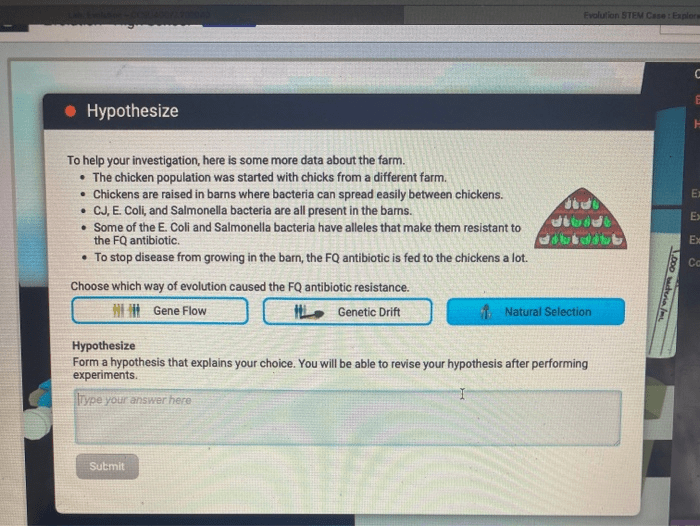The evolution stem case gizmo answer key provides a comprehensive guide to the Gizmo Evolution Simulation, an educational tool that models natural selection and genetic drift. This key offers detailed explanations for each question, illuminating the underlying principles of evolution and their significance in real-world evolutionary processes.
By delving into the concepts of stem cells, their regenerative potential, and the ethical considerations surrounding stem cell research, this narrative explores the intricate interplay between science and society. The case studies presented showcase the remarkable advances made in stem cell therapies, while highlighting the challenges and ongoing research efforts in this rapidly evolving field.
Stem Cell Definition and Characteristics
Stem cells are unspecialized cells that have the ability to self-renew and differentiate into a variety of specialized cell types. This makes them valuable for regenerative medicine, as they can potentially be used to replace damaged or diseased cells.There are two main types of stem cells: embryonic stem cells and adult stem cells.
Embryonic stem cells are derived from the inner cell mass of a blastocyst, and they are pluripotent, meaning they can differentiate into any type of cell in the body. Adult stem cells are found in various tissues throughout the body, and they are multipotent, meaning they can only differentiate into a limited number of cell types.Stem
cells are used in a variety of regenerative medicine applications, including:
- Treating blood disorders such as leukemia and sickle cell anemia
- Repairing damaged tissue after a heart attack or stroke
- Growing new organs for transplant
Gizmo Evolution Simulation

The Gizmo Evolution Simulation is an educational tool that models natural selection and genetic drift. The simulation allows users to create a population of organisms and then subject them to different environmental conditions. The simulation tracks the changes in the population over time, and it can be used to demonstrate how evolution occurs.The
simulation includes a number of parameters that can be manipulated, including:
- The population size
- The mutation rate
- The selection pressure
- The environmental conditions
The simulation can be used to demonstrate a variety of evolutionary concepts, including:
- The Hardy-Weinberg equilibrium
- The founder effect
- The bottleneck effect
- The role of natural selection in driving evolution
Answer Key for Gizmo Evolution Simulation
| Question | Answer |
|---|---|
| What is the effect of increasing the population size? | Increasing the population size reduces the impact of genetic drift and makes the population more likely to reach the Hardy-Weinberg equilibrium. |
| What is the effect of increasing the mutation rate? | Increasing the mutation rate increases the amount of genetic variation in the population and makes the population more likely to evolve. |
| What is the effect of increasing the selection pressure? | Increasing the selection pressure makes the population more likely to evolve in the direction of the selected trait. |
| What is the effect of changing the environmental conditions? | Changing the environmental conditions can change the selection pressure on the population and lead to the evolution of new traits. |
Case Studies on Stem Cell Research
There are a number of successful case studies of stem cell therapies for treating various diseases. For example, stem cells have been used to:
- Treat leukemia in children
- Repair damaged heart tissue after a heart attack
- Grow new skin for burn victims
- Restore vision in patients with macular degeneration
Stem cell research is still in its early stages, but it has the potential to revolutionize the treatment of a wide range of diseases.
Glossary of Key Terms
- Allele: A variant of a gene.
- Differentiation: The process by which stem cells become specialized cells.
- Evolution: The process by which populations of organisms change over time.
- Gene: A unit of heredity that is passed from parents to offspring.
- Genetic drift: The random change in the frequency of alleles in a population.
- Mutation: A change in the DNA sequence.
- Natural selection: The process by which organisms with traits that are better suited to their environment are more likely to survive and reproduce.
- Population: A group of organisms of the same species that live in the same area.
- Stem cell: An unspecialized cell that has the ability to self-renew and differentiate into a variety of specialized cell types.
User Queries: Evolution Stem Case Gizmo Answer Key
What is the significance of the Gizmo Evolution Simulation?
The Gizmo Evolution Simulation allows users to manipulate parameters and variables to observe the effects of natural selection and genetic drift on virtual populations. This interactive experience provides a valuable tool for understanding the mechanisms of evolution and their impact on genetic diversity.
How can stem cells be used in regenerative medicine?
Stem cells possess the ability to differentiate into various cell types, making them a promising source for tissue repair and regeneration. They have been used in clinical trials to treat a range of conditions, including spinal cord injuries, heart disease, and Parkinson’s disease.
What are the ethical considerations surrounding stem cell research?
Stem cell research raises ethical concerns regarding the use of human embryos and the potential for genetic manipulation. These ethical considerations must be carefully weighed against the potential benefits of stem cell therapies to ensure responsible and ethical advancements in this field.